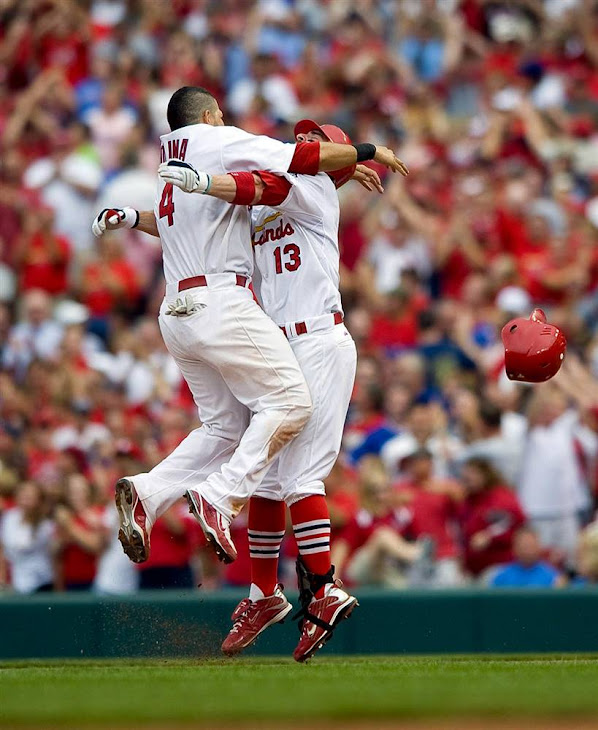Hey Guys, Its been a little while since I posted but news is kind of dry this time of year. I wrote the following paper for an English class this week and though it really doesn't have anything to do with the Cardinals, I think its a pretty good baseball paper.
A Five-Step Plan for Success in a Small Market
For the last fifteen or twenty years, small market teams have struggled to compete in Major League Baseball. There are many reasons for this, most notably free agency. Large market teams, like the New York Yankees and Los Angeles Dodgers, can afford payrolls that exceed $100 million. Smaller market teams, teams like the Kansas City Royals, Baltimore Orioles, Pittsburgh Pirates, etc., cannot afford to do this and must run better and smarter organizations to succeed. The following five-step plan illustrates how to do this.
The first step is the most important. In a small market, the front office and coaching staff must agree on an organizational philosophy; if the front office believes the team should be run one way and the coaching staff believes it should be run a different way, the team will fail. This starts with choosing a general manager. The general manager will be responsible for assembling the front office and the coaching staff. A good general manager can make the difference between an average team and a great team, so the small market team must choose wisely. Someone with experience as an assistant general manager in a successful small market city is a smart choice. A tired, older baseball guy who has not changed with the game and still believes spectators wear suits and ties and players wear stirrups would be a poor choice. Once a general manager has been chosen, it is time to look for a manager (head coach). Again, this is a very important decision. Joe Maddon transformed the Tampa Bay Rays from the worst team in baseball to the World Series runner up in two seasons. A good manager can do that. A bad manager can set your team back a decade. In choosing a manager, a small market team cannot just throw millions of dollars at the biggest name available. Lou Pinella and the Tampa Bay organization proved this strategy does not work. A small market team must look for someone who has had success in the minor leagues, which means someone who can win without superstars. Small market teams have few, if any, superstars.
The second step is by far the most difficult - a small market team must draft well. This sounds easy enough, but do not be fooled. Drafting in Major League Baseball is much more difficult than drafting in any of the other three major sports. A blue chip, five-tool prospect usually needs a minimum of three minor league seasons (most need far more) before he is ready for the major leagues. This is not the case in football or basketball; Lebron James averaged over 20 points per game in his first year out of high school and Mark Sanchez led the New York Jets to the AFC Championship game in his rookie campaign. What makes drafting in baseball so difficult? With three-plus minor league seasons needed for prospects, the chance of a player getting hurt and never playing in the major leagues is high - especially among pitchers, whose arms are more fragile than fine china. There are also many busts, especially among high school players who have never faced major league caliber competition. There are fifty rounds in the major league draft for a reason: in any given year, a team can expect that no more than two or three of their fifty draft picks will contribute in the major leagues. How can a small market team maximize each draft? A small market team should only select college players in the first ten rounds of the draft, not high school players. In those high rounds, players are usually being paid six or seven figure signing bonuses. Though there are no “sure things” in baseball, college players are more likely to become contributors than high school players because they have faced better competition. With less leverage than high school players, there is also far less chance that a college pick will refuse to sign and leave a small market team with a wasted draft pick.
Once a small market team has a drafting philosophy, it is time to pony up and pick a young player to build around. This is going to be pricey, near fifty or sixty million dollars, but it will be worth it in the long run (i.e. the Tampa Bay Rays and Evan Longoria). Who to pick, however, will not be an easy decision. If the drafting philosophy works as planned, your team will be rich with young talent. There will likely be five or six players who seem worthy of long-term, multi-million dollar deals. You only have the budget to pick one. Pitchers are not a smart choice; they will come and go and they will get hurt more frequently than position players. It is important to be strong up the middle. Therefore, look for a catcher, a shortstop, or a center fielder to build your franchise around. If you pick the wrong guy, and he busts, your franchise will be set back a decade or more (i.e. the Toronto Blue Jays and Vernon Wells).
The fourth step to building a successful small market baseball team is to make smart trades. This is the most subtle step, but it is pivotal. A team that has followed the second step should be rich in young talent and will not be able to afford re-sign all (or even most) of them. Therefore, you must trade them for role players and pitchers when they are at their maximum value. Though your team will be built around your one superstar, it must be strengthened with these role players. They will not make headlines, but they will make the difference between a mediocre team and a playoff team.
The fifth and final step to building a successful small market team is choosing one or two low-risk, veteran free agents each season. Though these players will be past their prime, they will add depth and leadership to a young clubhouse. These players will not hit .300 or 25 homeruns, but they will bring experience and will implant a winning culture in a club for years to come. Many times, this type of players will accept a low guaranteed, incentive-laden contract. Players like this will not be available every year, but when they are, a smart team will seize them before somebody else does.
This five-step plan is designed to deliver maximum success to small market teams. Inevitably, there will be injuries, there will be down seasons – making the playoffs every year is not a realistic expectation. A small market team’s expectation should be to be playing meaningful games deep into September every year. This five-step plan can make this expectation a reality.
Hope you guys enjoyed this. The anthem for the day is "The Needle & The Damage Done" by Neil Young. Have a great weekend everybody.




